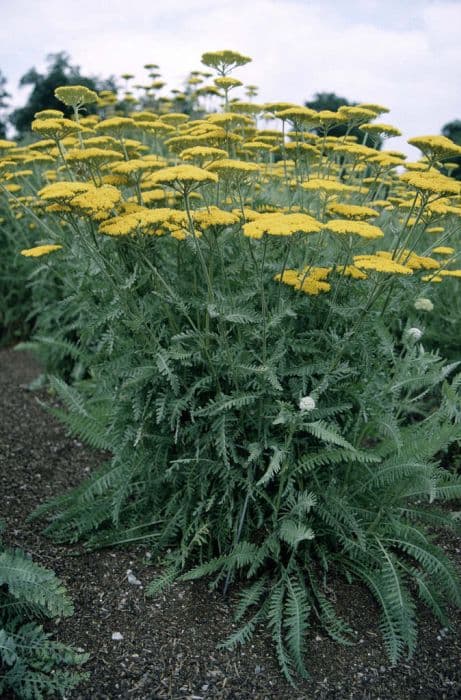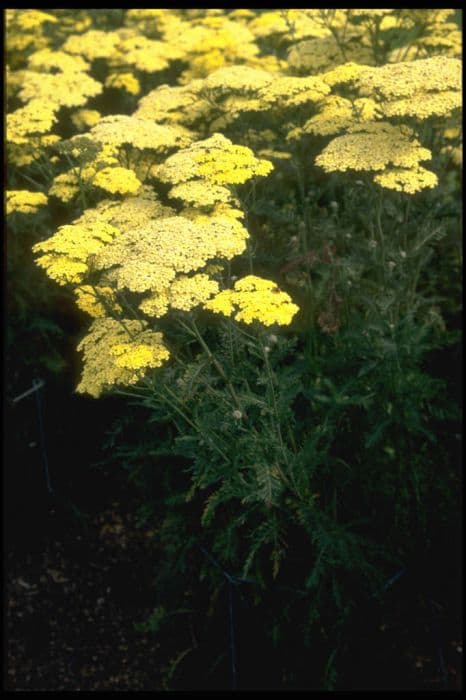Chrysanthemum Chrysanthemum 'Myss Saffron' (29c)

ABOUT
The Chrysanthemum 'Myss Saffron' is a vibrant and eye-catching plant known for its lush and decorative flowers. It boasts a rich palette of warm colors, with blooms that exude gorgeous shades of saffron yellow. The petals are numerous and densely packed, often exhibiting a frilly or quilled texture that adds depth and volume to the flower's appearance. Each bloom is composed of a central disk, typically of a darker hue, which is encircled by the radiant yellow petals that taper to a delicate point. The plant itself displays a mounded form with a profusion of flowers that create a spectacular display of color. The leaves of the Chrysanthemum 'Myss Saffron' are deep green, contributing a lush backdrop to the vivid blooms. They are generally lance-shaped and may exhibit a slightly serrated edge which provides a nice contrast to the smoothness of the petals. The foliage is layered, adding volume and fullness to the overall silhouette of the plant. Its stems are sturdy, supporting the weight and abundance of the flowers. In essence, the Chrysanthemum 'Myss Saffron' is a captivating spectacle with its warm, sun-like blooms that invite onlookers to gaze upon a natural embodiment of the color of saffron spices, evoking feelings of joy and the essence of autumn splendor.
About this plant
 Names
NamesFamily
Asteraceae
Synonyms
Garden Mum, Florist's Chrysanthemum, Hardy Chrysanthemum, Mum
Common names
Chrysanthemum 'Myss Saffron'
 Toxicity
ToxicityTo humans
Chrysanthemum, which includes the variety 'Myss Saffron,' is generally considered non-toxic to humans. However, some people may experience allergic reactions or skin irritation upon handling chrysanthemums or inhaling their pollen. If ingested, chrysanthemums may cause mild gastrointestinal upset, including nausea, vomiting, and diarrhea in some individuals.
To pets
Chrysanthemum can be toxic to pets, especially cats and dogs. If a pet ingests any part of a chrysanthemum plant, they may exhibit symptoms such as vomiting, diarrhea, hypersalivation, incoordination, and dermatitis. In severe cases, ingestion can lead to more serious conditions such as depression and muscle tremors. It's important to keep chrysanthemums out of reach of pets to prevent potential poisoning.
 Characteristics
CharacteristicsLife cycle
Perennials
Foliage type
Deciduous
Color of leaves
Green
Flower color
Yellow
Height
2-3 feet (60-90 cm)
Spread
2-3 feet (60-90 cm)
Plant type
Herb
Hardiness zones
5-9
Native area
Asia
Benefits
 General Benefits
General Benefits- Ornamental Value: Chrysanthemum 'Myss Saffron' is valued for its attractive, brightly colored flowers that enhance the beauty of gardens and landscapes.
- Long Blooming Season: These plants typically have a long flowering period, providing color and visual interest in the garden for an extended time.
- Variety of Uses: The flowers can be used in cut floral arrangements, adding vibrancy and decoration to indoor settings.
- Pollinator Attraction: They attract beneficial insects such as bees and butterflies, which facilitate the pollination of gardens and ecosystems.
- Easy to Grow: Chrysanthemums are generally easy to cultivate, requiring minimal care, which makes them suitable for gardeners of all skill levels.
- Drought Resistance: Once established, some cultivars may exhibit drought resistance, making them suitable for xeriscaping or low-water gardens.
- Fall Interest: They flower in the fall, providing color and interest in the garden at a time when many other plants are declining.
- Container Gardening: These plants can be grown in pots or containers, making them versatile for patios, balconies, or small spaces.
 Medical Properties
Medical PropertiesThis plant is not used for medical purposes.
 Air-purifying Qualities
Air-purifying QualitiesThis plant is not specifically known for air purifying qualities.
 Other Uses
Other Uses- The petals of Chrysanthemum can be used to create a natural dye for fabrics or paper, giving them a range of colors from golden to deep yellow;
- This plant can be used in companion planting to deter pests from nearby vegetables and other plants, as some pests dislike their scent;
- The leaves, when crushed, can serve as a natural insect repellent, warding off mosquitoes and other biting insects when rubbed on the skin;
- Chrysanthemum flowers can be incorporated into potpourris for a long-lasting fragrance or used to scent natural homemade candles and soaps;
- Dried Chrysanthemum petals can be used in the creation of floral arrangements or wreaths, maintaining their color and shape for a long time;
- The dried blooms can be used to fill sachets that freshen and protect clothes in drawers and wardrobes from moths;
- Chrysanthemum plants can be grown in a home garden to attract beneficial insects such as ladybugs and bees that aid in pollination and pest control;
- Used as a natural fertilizer, the decomposed plant material of Chrysanthemum can enrich the soil with nutrients as it breaks down;
- The flowers are sometimes used in crafts, such as pressed flower art, where their distinctive shape and color can add beauty to handmade cards and bookmarks;
- Chrysanthemum leaves can be steeped to create a bitter but aromatic tea that is enjoyed in various cultures, although this is more common with certain species of Chrysanthemum.
Interesting Facts
 Feng Shui
Feng ShuiChrysanthemums are associated with happiness and well-being in Feng Shui, and they are believed to bring strong yang energy into the home. To use chrysanthemums effectively, place them in areas like the living room to promote joy and good health, or in the office space to foster balance and maintain healthy relationships.
 Zodiac Sign Compitability
Zodiac Sign CompitabilityThe chrysanthemum is not used in astrology practice.
 Plant Symbolism
Plant Symbolism- Longevity and Immortality: Chrysanthemums are often associated with long life and immortality due to their ability to bloom into the autumn when other flowers have faded.
- Rebirth and Renewal: The recurring blooming season symbolizes the cycles of rebirth and the renewal of life.
- Loyalty and Devotion: In some cultures, giving a chrysanthemum signifies a vow of fidelity or a display of devoted affection.
- Death: In some European countries, chrysanthemums are symbolic of death and are often used in funerary arrangements.
- Nobility: In Japan, the chrysanthemum is a noble flower, representing the sun and the Imperial family.
 Water
WaterMums, including Chrysanthemum 'Myss Saffron', should be watered regularly to keep the soil evenly moist but not soggy. In general, watering deeply once a week with about 1 gallon per plant is sufficient. However, this may vary depending on climate conditions, with more frequent watering required in hot, dry weather. It’s important to water the plant at the base, avoiding wetting the foliage, which can invite disease. During the growing season, if there is less than 1 inch of rainfall weekly, additional watering will be necessary.
 Light
LightMums thrive in full sunlight, so the best spot for Chrysanthemum 'Myss Saffron' is a location where it can receive at least six hours of direct sunlight daily. They will tolerate partial shade, but too little light can lead to weak stems and sparse blooms. Ensure the chosen spot provides bright light for the majority of the day to promote strong growth and vibrant flowers.
 Temperature
TemperatureMums prefer moderate temperatures and will flourish when the daytime temperatures are between 60°F and 75°F. Chrysanthemum 'Myss Saffron' can survive temperature ranges from a low of about 32°F to a high of around 90°F, but for sustained health and blooming, aim to provide conditions within the ideal range. Protecting the plant from extreme temperatures by providing shade during the hottest part of the day or mulch to insulate roots during colder periods can help maintain a suitable environment.
 Pruning
PruningPruning Mums like Chrysanthemum 'Myss Saffron' is crucial for maintaining a bushy, compact shape and encouraging more blooms. Prune the tips of the stems in early summer to promote branching, cutting back about 1 inch of growth. Another light pruning may be done if needed by mid-summer. Avoid pruning too late in the season as this can remove bud sites and reduce fall flowering. The best time for significant pruning is after the blooming cycle when the plant enters dormancy.
 Cleaning
CleaningAs needed
 Soil
SoilMums require well-drained soil with a pH of 6.5-7.0. A mix of garden soil, peat moss, and perlite in equal parts works well for Chrysanthemum 'Myss Saffron', ensuring good drainage and aeration.
 Repotting
RepottingChrysanthemum 'Myss Saffron' should be repotted every 1-2 years or when it becomes root-bound. Spring is the best time to repot mums to promote healthy growth and bloom.
 Humidity & Misting
Humidity & MistingMums prefer a moderate humidity level, around 60-65%. Avoid overly dry air to keep the Chrysanthemum 'Myss Saffron' healthy but also ensure good air circulation to prevent diseases.
 Suitable locations
Suitable locationsIndoor
Place in bright, indirect light and away from drafts.
Outdoor
Plant in sunny spot with well-draining soil.
Hardiness zone
5-9 USDA
 Life cycle
Life cycleThe life of Chrysanthemum 'Myss Saffron' (a variety of mum or chrysanthemum) begins with seed germination, where temperature and light conditions trigger the growth of the seed into a small seedling. Following germination, the seedling enters the vegetative stage, where it develops a root system, stems, and leaves through the process of photosynthesis and nutrient absorption. When mature enough and given suitable environmental conditions, the plant enters the flowering stage, characterized by the development of buds that bloom into the distinctive saffron-colored flowers. After pollination, which may be facilitated by insects or wind, the flowers produce seeds, marking the plant's reproductive stage. The mum will then go through a period of senescence as it begins to deteriorate, and if the plant is an annual, it will die after setting seed. However, if it is a perennial variety, it may go dormant for some time, typically during colder months, and resume growth with the return of favorable conditions in the next growing season.
 Propogation
PropogationPropogation time
Spring-Early Summer
Propogation: Chrysanthemum 'Myss Saffron', commonly known as mums, can be propagated effectively using stem cuttings, usually in the spring. To do this, select a healthy, non-flowering shoot and cut a piece around 4 to 6 inches (10-15 cm) long. Strip the leaves from the lower half of the cutting and dip the cut end in a rooting hormone to encourage root development. Plant the cutting in a pot filled with a mix of peat and perlite or coarse sand, ensuring the leafless part is buried. Water the soil lightly to settle it around the cutting and place the pot in a warm, well-lit area, avoiding direct sunlight until roots establish. Roots typically develop within a few weeks, at which point the new mum plants can be gradually acclimatized to outdoor conditions before planting out.









